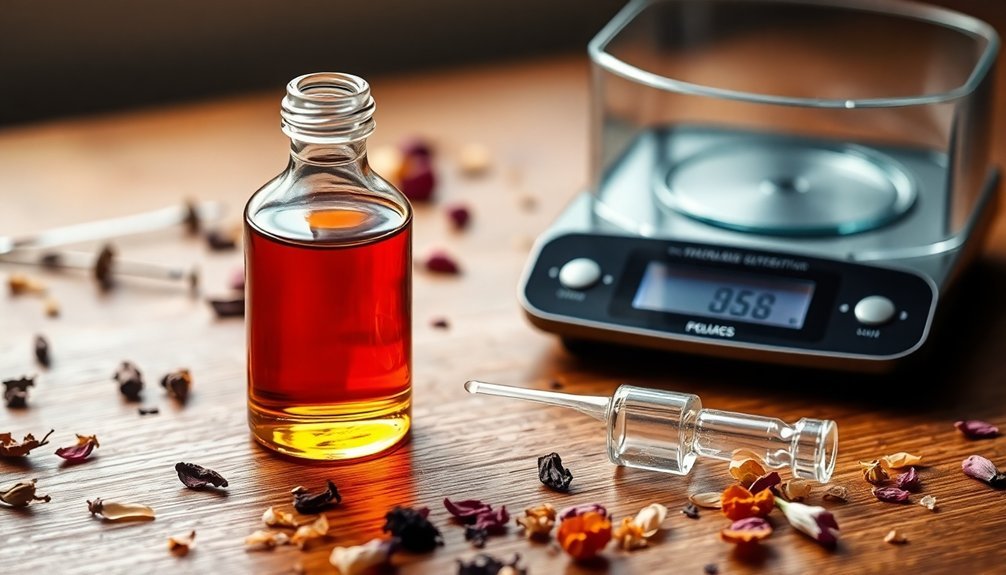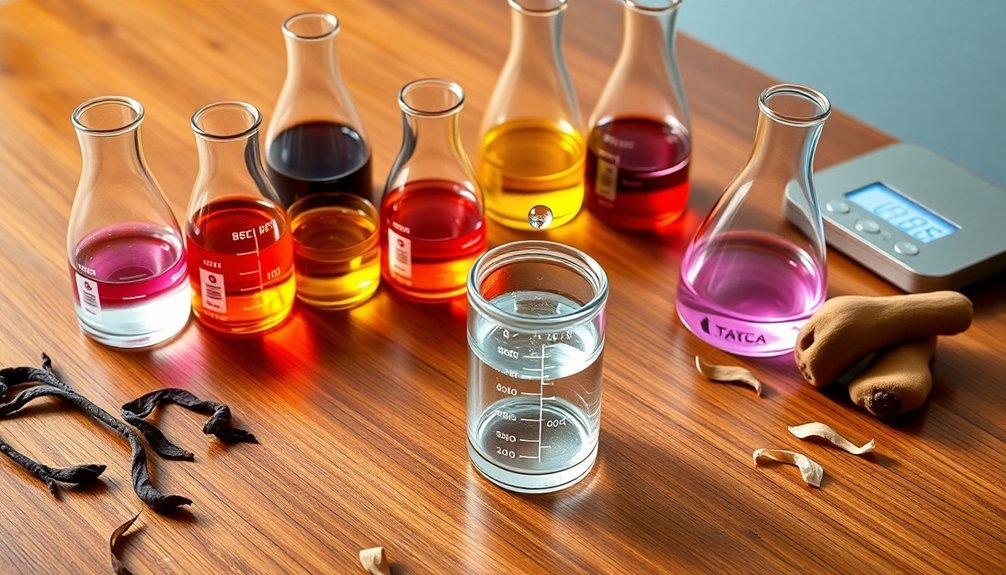To calculate perfume base notes, start with a 20% concentration by mixing 6ml of base note oils with 24ml of perfumer's alcohol in a 30ml bottle. You'll want to follow the 30/50/20 rule, where base notes make up 20% of your total fragrance composition. Use a digital scale for precise measurements, aiming for 0.01g accuracy. If you're ready to master professional perfumery techniques, there's much more to explore about dilution ratios and blending methods.
Understanding Base Note Concentrations

When creating or selecting a perfume, understanding base note concentrations across different fragrance types is essential for achieving your desired effect.
Parfum contains the highest concentration of perfume oils (20-40%) and delivers the richest base notes, lasting up to 8 hours. Base notes become more prominent as the fragrance develops, creating a long-lasting aromatic foundation.
Eau de Parfum follows with 15-20% concentration and prominent heart notes, while still maintaining significant base notes for 4-5 hours.
You'll find lower base note concentrations in Eau de Toilette (5-15%) and Eau de Cologne (2-5%), which emphasize top notes and fresh scents respectively.
Eau de Toilette lasts 3-4 hours, while Cologne only maintains its scent for 1-2 hours.
Eau Fraîche contains the lowest concentration at 1-3%, with minimal base notes and a water-based formula that lasts less than 2 hours.
Basic Dilution Mathematics
Basic math skills form the foundation of creating precise perfume dilutions.
You'll need to master simple calculations to achieve accurate concentrations for your base notes. Understanding the relationship between weight, volume, and percentages is vital for successful dilutions. Using a calibrated scale ensures measurement accuracy when creating dilutions.
To create precise dilutions, follow these essential steps:
- Calculate your target dilution percentage (e.g., 10% = 1 part raw material to 9 parts solvent)
- Convert between weight and volume using the solvent's specific gravity (ethanol = 0.8)
- Measure ingredients with precision tools (scales for solids, pipettes for liquids)
- Document your calculations and double-check your math before mixing
Remember to use the basic dilution formula: (Raw Material / Total Volume) * 100 = Dilution Percentage.
This guarantees consistent results across all your perfume bases.
Essential Tools for Base Note Calculations

Creating precise base note calculations requires specific tools that guarantee accuracy and consistency in your perfume formulations. You'll need a digital scale that measures to 0.01g, as drops aren't reliable for exact measurements. Graduated pipettes and spreadsheet software will help you track and calculate your formulas accurately. The odor strength values must be carefully documented to ensure proper blending of base notes.
| Tool Type | Purpose | Essential Feature |
|---|---|---|
| Digital Scale | Precise Measurements | 0.01g accuracy |
| Software | Formula Tracking | Automated calculations |
| Safety Guides | IFRA Compliance | Maximum % limits |
For systematic calculations, you'll want to use Google Sheets or Excel with pre-designed templates that automatically compute dilutions and concentrations. These tools should include fields for material dilutions and IFRA restrictions. Don't forget to incorporate note ratio guides, which typically suggest 5-10% base notes in your final composition.
Base Note to Alcohol Ratios
The successful formulation of perfumes hinges on maintaining precise ratios between base notes and alcohol. When you're working with a 30ml mixture, you'll want to follow standard ratios that guarantee proper fragrance distribution and longevity.
- Start with a 10-30% fragrance concentration, depending on your desired strength.
- Use 12 drops of base notes, 18 drops of middle notes, and 10 drops of top notes for a 30ml blend.
- Consider starting with a conservative 10% ratio (3ml fragrance to 30ml alcohol) when using fragrance oils.
- Always check your IFRA certificate to confirm you don't exceed maximum usage rates.
You can adjust these ratios based on your specific needs, but remember that higher concentrations aren't always better.
The key is finding the sweet spot that delivers ideal fragrance performance while maintaining safety standards.
Step-by-Step Dilution Process

Now that you understand the correct ratios, mastering the dilution process will guarantee your perfume's success.
Start by selecting your dilution medium – perfumer's alcohol works best for most blends, while DPG offers excellent solubility and fixative properties. If you're creating oil-based perfumes, stick with carrier oils.
You'll need to dilute your materials to specific concentrations, typically ranging from 20% down to 0.5%, depending on your formula. Use a pipette for precise measurements and always work with weight-to-weight ratios for accuracy.
Store your diluted materials in clean, labeled containers to prevent contamination.
Once you've diluted your base notes, you can combine them with middle and top notes. Let your blend age to allow the ingredients to merge, then test it thoroughly before making final adjustments.
Common Base Note Measurements
When measuring base notes for your perfume formulation, precise calculations become essential for achieving the right intensity and lasting power. Base notes typically comprise 15-30% of your total perfume composition, making them vital for the fragrance's foundation and longevity.
- The standard measurement for vanilla and amber is 10-15% of your base note portion, as these ingredients provide warmth without overpowering other notes.
- Musk should be used at 5-10% concentration to enhance scent duration while maintaining balance.
- Woody notes like sandalwood and cedarwood work best at 8-12% to create an earthy foundation.
- Patchouli is effective at 3-8% concentration, as its strong nature can easily dominate the composition.
Remember that these percentages may need adjustment based on the specific ingredients' intensity and your desired fragrance profile.
Troubleshooting Dilution Errors

When working with base notes, you'll likely encounter two common concentration mistakes: over-dilution that weakens your scent profile and under-dilution that creates an overpowering fragrance.
To fix measurement errors in over-diluted mixtures, carefully add small amounts of fragrance oil until you achieve the desired strength, while under-diluted blends require additional carrier substance to reduce potency.
You can prevent these issues by keeping detailed records of your dilution ratios and conducting patch tests after each adjustment.
Common Concentration Mistakes
Creating the perfect fragrance concentration requires careful attention to detail, as even small mistakes can dramatically alter your perfume's performance.
If you're working with essential oils and fragrance materials, you'll need to understand proper concentration ratios for different types of perfumes.
- Always match your concentration to the intended use – EDPs (15-20%) work best for evening wear, while EDTs (5-15%) suit daily use.
- Don't skip proper dilution steps – use serial dilutions for strong materials to avoid overwhelming your blend.
- Use alcohol as your primary dilution medium to maintain stability and guarantee even distribution.
- Consider your skin type and environment when calculating concentrations – acidic skin and humidity can affect how your fragrance performs.
Fixing Measurement Errors
Despite careful planning, dilution errors can occur even among experienced perfumers. When you notice inconsistencies in your fragrance concentrations, you'll need to take immediate corrective action.
Start by re-evaluating your measurements using a precise scale that measures to 0.01g instead of relying on drops. If your mixture is too strong, add your carrier oil gradually while documenting each adjustment. For alcohol-based perfumes, use perfumer's alcohol to achieve the right balance.
Remember to test small batches before scaling up production. To prevent future errors, maintain detailed records of your dilution ratios and always use proper measuring equipment.
You'll want to take into account the type of diluent and verify it's compatible with your materials. Test each adjustment with a patch test before finalizing your formula.
Base Note Blending Techniques
The art of blending base notes requires a delicate balance of technique and intuition. When you're working with deep, lasting scents like sandalwood, myrrh, or vetiver, you'll need to add them carefully to avoid overwhelming your blend.
Start with small amounts and follow the 30/50/20 rule, using 20% base notes in your total mixture.
- Begin with fixative base notes like benzoin or amyris to stabilize your blend.
- Add your primary base notes drop by drop, testing as you go.
- Combine with middle and top notes in specific ratios for balance.
- Use blenders to harmonize the overall fragrance.
Remember that base notes have heavier molecules that move slowly, so they'll become more prominent over time.
You'll want to guarantee they complement rather than dominate your final perfume composition.
Storage and Stability Guidelines

Maintaining your perfume's quality and longevity depends heavily on proper storage conditions.
You'll want to store your fragrances in a cool, dry place with temperatures between 15-20°C and humidity levels below 50%. Keep your perfumes away from bathrooms, kitchens, and direct sunlight.
To prevent oxidation, always tighten the cap after each use and avoid shaking the bottle unnecessarily.
You'll know your perfume is aging if you notice color changes or shifts in the scent profile. Store bottles upright in their original packaging, and don't transfer them to decorative containers.
Consider using silica gel packets to control moisture, and keep your perfumes away from heating or cooling vents.
For extra protection, store them in dark, shaded areas or their original boxes to shield them from UV exposure.
Frequently Asked Questions
Can I Substitute Vodka for Perfumer's Alcohol in Base Note Dilutions?
You shouldn't substitute vodka for perfumer's alcohol in base notes. Its lower 40% alcohol content won't properly dissolve and stabilize the fragrance components, leading to inconsistent results and potential scent alterations.
How Long Should Base Notes Mature Before Adding Heart Notes?
You'll want to let your base notes mature for at least 4-6 weeks before adding heart notes. This gives the heavier molecules time to blend and stabilize, creating a solid foundation for your fragrance.
Do Synthetic Base Notes Require Different Dilution Calculations Than Natural Ones?
No, you'll use the same dilution calculations for both synthetic and natural base notes. The math doesn't change based on ingredient type – just follow the standard formula for your desired concentration percentage.
What's the Ideal Temperature Range for Calculating and Mixing Base Notes?
You'll want to mix base notes between 65-75°F (18-24°C), staying below the flashpoint. Don't exceed room temperature, as higher heat can alter the fragrance composition and reduce the scent's longevity.
Will Adding Glycerin Affect the Base Note Dilution Calculations?
No, adding glycerin won't considerably affect your base note dilution calculations. You can treat it as a supplementary ingredient since it's typically used in small amounts primarily for preservation and stability purposes.
In Summary
You've now mastered the basics of calculating perfume base note dilutions. Remember to double-check your measurements, maintain precise ratios, and always document your formulations. While it may seem complex at first, these calculations will become second nature with practice. Keep your workspace organized, store your dilutions properly, and don't forget that successful perfumery relies on both precise math and artistic intuition.





Leave a Reply